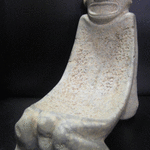Taino Green Stone Metate (Duho), 1100 CE - 1500 CE
Stone
27.9 x 24.4 cm
11 x 9 5/8 in
11 x 9 5/8 in
FF.037
Further images
Taino communities were the first that Columbus encountered during his exploration of Hispaniola in 1492. Traditional Pre-Columbian scholarship focused on the mainland societies of the Incas, Aztecs and Maya, but...
Taino communities were the first that Columbus encountered during his exploration of Hispaniola in 1492. Traditional Pre-Columbian scholarship focused on the mainland societies of the Incas, Aztecs and Maya, but since the 1950s there has been growing awareness that Taino culture was highly sophisticated and deserves more detailed study. Politically, the Taino were divided up into separate communities ruled by chieftains (caciques) whose power had increased considerably by the time of the Spanish arrival. Religiously, the Taino were polytheistic and worshipped a pantheon of gods who were believed to control the natural elements. Ancestor worship was also important and the deification of deceased chieftains reinforced the political authority of their successors. An elaborate ritual system was developed to honour and placate these deities (zemis) and this probably provides the context for the present piece.
In form, this stone carving resembles a ceremonial seat with a high-back, known as the duho. The majority of these were carved from wood and inlaid with precious materials such as gold and bone. The perishable nature of this material means that surviving examples are rare. Duhos were used at important social events, such as the ball-games or during cohoba ceremonies when Taino shamans contacted the spirits of the dead. The Taino chieftains controlled the production of distribution of these seats and their use was reserved for those of the highest status. This example is rather small to have functioned as a seat- so there are several possibilities. It could represent a miniature duho for burial with the dead or perhaps another religious ceremony. It could also be a metate used for grinding the cohoba with a pestle. Metates were popular throughout the Pre-Columbian world, especially in Costa Rica, where they were carved from volcanic-stone. However the majority of Costa Rican examples are zoomorphic in form. It was quite unsual among Pre-Columbian societies to produce metates in human form. The Taino seem to have specialized in this genre, and this carving depicts a man reclining on his back. The face is skeletal in form with circular sunken eye-sockets and a wide gaping mouth. The arms have been lengthened but the feet are foreshortened. An erect phallus is visible between the bent knees and suggests some link with fertility rites. This is a remarkably inventive and dynamic carving that would enhance any serious collection of Pre-Columbian art. (AM)
In form, this stone carving resembles a ceremonial seat with a high-back, known as the duho. The majority of these were carved from wood and inlaid with precious materials such as gold and bone. The perishable nature of this material means that surviving examples are rare. Duhos were used at important social events, such as the ball-games or during cohoba ceremonies when Taino shamans contacted the spirits of the dead. The Taino chieftains controlled the production of distribution of these seats and their use was reserved for those of the highest status. This example is rather small to have functioned as a seat- so there are several possibilities. It could represent a miniature duho for burial with the dead or perhaps another religious ceremony. It could also be a metate used for grinding the cohoba with a pestle. Metates were popular throughout the Pre-Columbian world, especially in Costa Rica, where they were carved from volcanic-stone. However the majority of Costa Rican examples are zoomorphic in form. It was quite unsual among Pre-Columbian societies to produce metates in human form. The Taino seem to have specialized in this genre, and this carving depicts a man reclining on his back. The face is skeletal in form with circular sunken eye-sockets and a wide gaping mouth. The arms have been lengthened but the feet are foreshortened. An erect phallus is visible between the bent knees and suggests some link with fertility rites. This is a remarkably inventive and dynamic carving that would enhance any serious collection of Pre-Columbian art. (AM)





